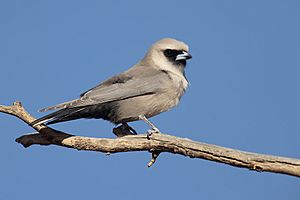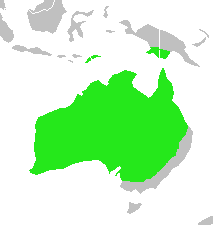Black-faced woodswallow facts for kids
Quick facts for kids Black-faced woodswallow |
|
|---|---|
 |
|
| Conservation status | |
| Scientific classification | |
| Genus: |
Artamus
|
| Species: |
cinereus
|
 |
|
The black-faced woodswallow (Artamus cinereus) is a cool bird found in Australia, New Guinea, and some nearby islands like Timor. It belongs to a group of birds called woodswallows. This bird is about 18 to 19 centimeters long. It is the most common type of woodswallow in its bird family, called Artamidae. Black-faced woodswallows make soft sounds like "chiff" and "chap." They can also copy the calls of other birds!
Sometimes, there is too much plant growth in areas like the Cape York Peninsula. This has caused the number of woodswallows to go down since 1993.
Contents
What They Look Like
The black-faced woodswallow is about 18 to 19 centimeters long. It weighs between 32 and 40 grams. It has a blue-grey beak with a black tip. A black mask covers its face, going from its beak up to and around its eyes.
Its body feathers are ash grey. The feathers on its chest are lighter, and its wings are darker. The underside of its wings is silver. Its tail is black with a white tip.
There are four different types, or subspecies, of black-faced woodswallows. You can tell them apart by the color of their tail vents (the area under their tail). Some have white vents, and others have black vents.
- The white-vented types, A.c. normani and A.c.dealbatus, live in northern Queensland.
- The black-vented types, A.c. cinereus and A.c.melanops, live in other parts of Australia and islands like Timor.
Male and female woodswallows look very similar. Young woodswallows, called juveniles, have brown bodies and wings. They have buff-colored streaks and a pale yellow beak. Their calls are soft and chattering, and they can mimic other bird sounds.
Where They Live
Black-faced woodswallows live all over Australia. They are found almost everywhere except the very eastern coast. These birds usually stay in one place. They live in dry and semi-dry areas, even when it's very dry.
They like open eucalypt woodlands, scrub, and grassy areas. In tropical areas, they prefer open woodlands and grasslands. Woodswallows often fly together with other birds like finches and even the golden-shouldered parrot.
How They Live
What They Eat
Black-faced woodswallows mostly eat insects. They are very good at catching insects while flying. They can soar, hover, and dive to catch moths and other bugs. They also eat insects they find on the ground. Sometimes, they catch an insect and then take it apart to eat it.
These birds have special brush-like tongues. This helps them get nectar from flowers, which they sometimes eat too.
Their Behavior
Black-faced woodswallows are special because they are "communal breeders." This means many birds help feed the young, not just the parents. This behavior helps them survive in dry areas where food can be hard to find.
They also like to flock together and roost (rest) in groups. They do this during the day and night. Huddling together helps them stay warm, protects them from wind, and keeps them safe from predators.
They usually breed once a year, often after it rains and there are lots of insects. This is usually between August and September. The male and female birds look alike. During courtship, they spread their wings and fan their tails.
They build their nests in tree hollows, cracks, or on top of stumps. They often use the same nesting spots every year. Building a nest takes about 4 to 7 weeks. Nests are made of twigs and coarse grass, lined with softer grass.
The eggs are oval-shaped and about 17-22mm in size. A female usually lays 3 or 4 eggs. The eggs are white or dull white with red-brown blotches and lavender speckles. The parents sit on the eggs for 14 to 16 days. The chicks leave the nest about 18 days after hatching.
Young birds are at risk from predators like hawks, butcher birds, and kookaburras. But the parent woodswallows make alarm calls and attack predators to keep their young safe. Other birds, like parrots, sometimes feed near woodswallows. This helps them stay safer too, because the woodswallows are good at defending their area.
Subspecies of Woodswallows
As mentioned, there are four different types of black-faced woodswallows. These types are separated by mountain ranges and grasslands. The types with white vents live to the east of these areas. The types with black vents live to the west.
Sometimes, these different types meet and have babies together in areas where their territories overlap. This shows that they can still interbreed. The black-vented woodswallows are better at living in dry areas. The white-vented ones are better at living in tropical areas. This means they probably won't mix completely into one type.
Helping Other Birds
In the Cape York Peninsula, black-faced woodswallows often live near golden-shouldered parrots and finches. This is very important for the parrots, which are an endangered species.
Woodswallows build their nests in open areas, like on gravel slopes. They often eat insects on the ground. They are also very good at defending their territory from predators. This helps protect the parrots that feed nearby.
However, the number of woodswallows in Cape York Peninsula has gone down since 1993. This is because there are too many plants growing due to changes in how fires are managed. This extra plant growth makes it easier for predators to catch the golden-shouldered parrots.
Fire Management
Even though the black-faced woodswallow is not currently considered endangered, its numbers have dropped a lot in some areas, especially in the Cape York Peninsula. This is mainly because of too much plant growth.
Recently, a new way of managing fires, called "storm-burning," has been used. This has helped stop the decline of the woodswallow population. Storm-burning creates more open areas. This is good for the woodswallows because it helps them find insects and build their nests.
See also
 In Spanish: Artamo carinegro para niños
In Spanish: Artamo carinegro para niños


